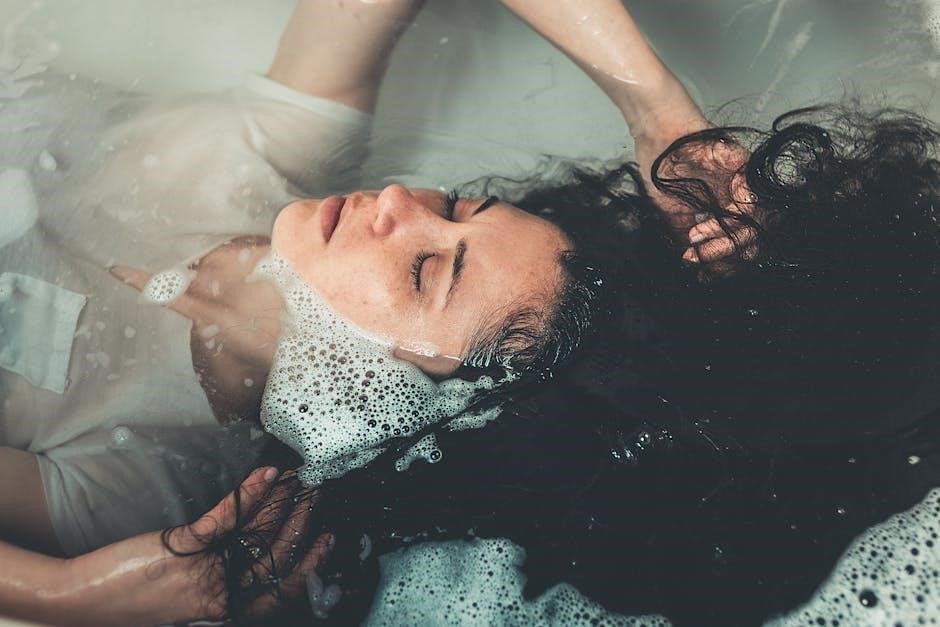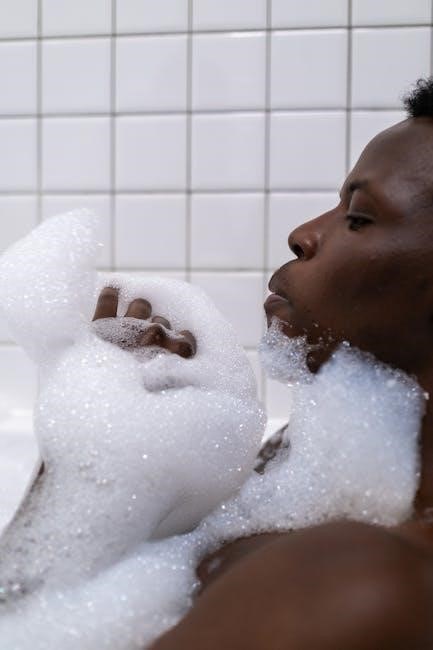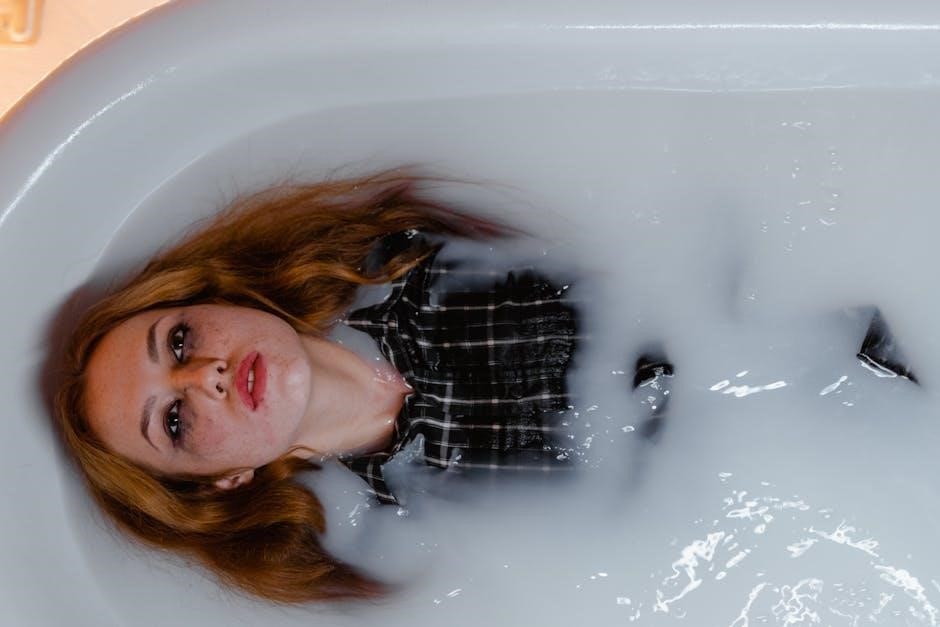A bleach bath for hair is a diluted lightening method using bleach powder, developer, and shampoo, applied to wet hair for a gentler, cost-effective way to achieve lighter shades without over-processing.
What is a Bleach Bath?

A bleach bath is a hair lightening technique that involves mixing bleach powder, developer, and shampoo. It is applied to wet hair to create a diluted solution, reducing the risk of over-processing. This method is less damaging than traditional bleaching and allows for gradual lightening, making it ideal for achieving subtle color changes or maintaining existing shades.
The process typically involves applying the mixture evenly, often focusing on the ends for a natural-looking gradient. Unlike standard bleaching, a bleach bath is gentler and customizable, making it a popular choice for those seeking lighter hair with minimal damage.
Benefits of Using a Bleach Bath for Hair
A bleach bath is a cost-effective and gentle method for lightening hair. It reduces damage compared to traditional bleaching, making it ideal for maintaining color-treated hair. This technique allows for subtle, gradual lightening and is less harsh on the hair shaft, minimizing breakage. It is also customizable, enabling users to achieve specific shades without over-processing. Additionally, it can be used to remove unwanted dye or toners, offering flexibility for those seeking lighter or pastel hues. Overall, a bleach bath is a versatile and damage-minimizing option for hair lightening.
Preparation for a Bleach Bath
Before starting, gather materials like gloves, towels, shampoo, and developer. Conduct a strand test and ensure hair is dry and combed. Wear protective gear to avoid damage and ensure safety during the process.
Materials Needed
To prepare for a bleach bath, you will need several essential items. These include gloves to protect your hands, a towel to wrap your shoulders, and a plastic cap for processing. You’ll also need a mixing bowl, a tint brush for application, and a well-ventilated workspace. Additionally, gather your bleach powder, developer (preferably 10-20 volume), clarifying shampoo, and warm water. A strand test kit is crucial for checking results before full application. Timing is important, so have a timer ready. Lastly, ensure you have protective clothing to avoid stains and damage.
Safety Precautions
Before proceeding with a bleach bath, ensure all safety measures are in place. Always perform a strand test to check for allergic reactions or unexpected results. Wear protective gloves and old clothing to avoid stains. Apply petroleum jelly around your hairline and ears to prevent irritation. Conduct the process in a well-ventilated area to avoid inhaling strong fumes. Avoid applying bleach to damaged or over-processed hair, as it may cause breakage. If you have sensitive skin or scalp conditions, consult a professional beforehand. Keep the bleach solution away from eyes and rinse thoroughly if accidental contact occurs. Timing is crucial, so monitor the process closely to prevent over-processing. Always follow the instructions provided with the bleach kit and consider doing a patch test 48 hours before application to ensure safety.

Application Process
A bleach bath involves applying a mixture of bleach powder, developer, and shampoo to wet hair, creating a gentler lightening process with minimal damage risk.
Mixing the Bleach Bath Solution
Combine bleach powder and developer in a well-ventilated area, following the product instructions for precise measurements. Add a small amount of clarifying shampoo to the mixture to help distribute the bleach evenly. Mix thoroughly until the solution is smooth and free of lumps. Ensure the mixture is at room temperature before application to avoid uneven results. Always perform a strand test to check the effectiveness and avoid over-processing.
Applying the Bleach Bath to Hair
Apply the bleach bath solution to damp hair, starting at the ends and working upwards to avoid over-processing the scalp. Use an applicator bottle for even distribution. Gently massage the solution into your hair, ensuring thorough coverage. Avoid applying directly to the scalp to prevent irritation. Processing time ranges from 20 to 45 minutes, depending on hair condition and desired results. Rinse thoroughly with warm water after processing, followed by a moisturizing shampoo and conditioner to restore hydration.
Important Considerations
Always conduct a strand test before applying a bleach bath to check processing time and results. Monitor development closely to avoid over-processing and potential hair damage.
Strand Test Before Application
A strand test is essential before applying a bleach bath to ensure desired results and avoid damage. Select a small section of hair, mix the bleach solution, and apply it. Monitor processing time closely, checking every 10 minutes. Rinse thoroughly and evaluate color and condition. This step helps identify potential issues, such as uneven lightening or over-processing. It also ensures the bleach bath formula is suitable for your hair type and color. Always prioritize a strand test to achieve safe and effective hair lightening results.
Timing and Development
Timing is critical during a bleach bath application. Development time varies based on hair color, condition, and desired results. Generally, 15–45 minutes is recommended, with frequent checks every 5–10 minutes. Over-processing can cause damage or unwanted tones. For darker hair, longer processing may be needed, while lighter shades require less time. Use a clock to monitor and rinse immediately if desired results are achieved. Proper timing ensures effective lightening while minimizing potential harm to your hair. Always follow instructions and adjust based on hair type and porosity for optimal outcomes.

Maintenance and Aftercare
After a bleach bath, use sulfate-free shampoo and moisturizing conditioner to restore hydration. Avoid heat styling and further chemical treatments to prevent damage and maintain hair health.
Post-Bleach Hair Care
After a bleach bath, proper care is essential to restore hair health and maintain results. Use sulfate-free shampoo and conditioner to preserve color and moisture. Deep conditioning treatments can repair damage, while protein treatments strengthen hair structure. Avoid heat styling for at least two weeks and minimize further chemical treatments. Moisturizing masks and leave-in conditioners help hydrate dry ends. Regular trims prevent split ends from spreading. To maintain vibrancy, rinse hair with cold water after washing and avoid prolonged sun exposure.
- Use sulfate-free products to retain moisture and color.
- Deep conditioning treatments repair damage and restore elasticity.
- Avoid heat tools and additional chemical treatments.
- Moisturizing masks and leave-in conditioners hydrate dry ends.
- Regular trims prevent split ends from spreading.
- Rinse with cold water to close cuticles and maintain vibrancy.
Avoiding Damage
To minimize damage during a bleach bath, conduct a strand test to assess how your hair reacts to the solution; Use a lower developer strength for fragile hair and avoid over-processing by adhering to recommended timing. Rinse thoroughly to stop the bleaching action promptly. Avoid applying bleach to already damaged or over-processed hair, and consider using a conditioning treatment immediately after rinsing. Regular moisturizing and protein treatments can help restore hair health over time.

- Conduct a strand test to gauge hair’s reaction to bleach.
- Use lower developer strength for fragile or damaged hair.
- Avoid over-processing by following time guidelines.
- Rinse thoroughly to halt the bleaching process.
- Apply conditioning treatments post-bleach to restore moisture.
- Moisturizing and protein treatments aid in recovery.

Troubleshooting Common Issues
Common issues with bleach baths include uneven results, over-processing, or brassy tones. To fix, reapply bleach carefully, tone with purple shampoo, or consult a professional for correction.
Dealing with Uneven Results
Uneven results can occur due to inconsistent application or varying hair porosity. To address this, reapply the bleach bath only to the darker areas, avoiding over-processing. Use a strand test to determine the correct development time. For minor discrepancies, tone the hair with a purple or ash-based shampoo to neutralize warm tones. For severe unevenness, consult a professional for a color correction treatment. Always follow safety guidelines and perform a patch test before reapplying any bleach solution to ensure the best outcome and minimize further damage.
Correcting Over-Processing

Over-processing can lead to damaged, brittle hair. To correct this, immediately rinse and condition with a deep moisturizing treatment. Avoid further bleaching and use protein-based products to repair bonds. For color correction, apply a toner to achieve the desired shade. Reduce heat styling and use sulfate-free products to maintain health. If damage is severe, consider a hair mask regimen or professional repair treatment. Prevention is key, so always perform strand tests and follow recommended timing to avoid over-processing in future bleach bath applications.
A bleach bath can be an effective and gentle way to lighten hair when done correctly. Always prioritize safety by performing strand tests and following instructions carefully. Proper aftercare is essential to maintain healthy, vibrant hair post-bleaching.
For best results, use moisturizing products and avoid excessive heat styling. If unsure, consult a professional. Remember, patience and caution lead to the desired outcomes without compromising hair health. Happy bleaching!